ICSE Class 10 Biology The Circulatory System Questions and Answers
ICSE SolutionsSelina ICSE Solutions
APlusTopper.com provides ICSE Solutions for Class 10 Biology Chapter 6 The Circulatory System for ICSE Board Examinations. We provide step by step Solutions for ICSE Biology Class 10 Solutions Pdf. You can download the Class 10 Biology ICSE Textbook Solutions with Free PDF download option.
Download Formulae Handbook For ICSE Class 9 and 10
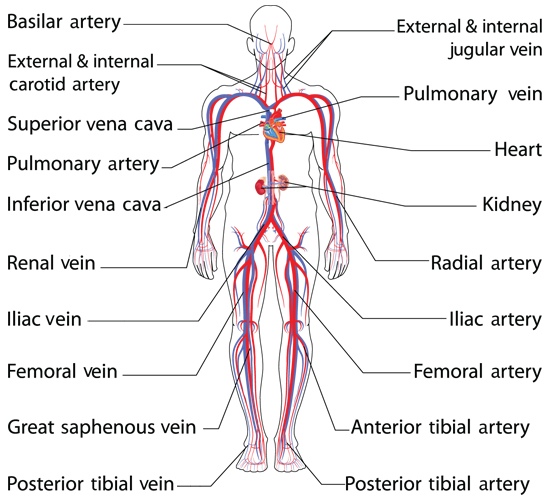
Short Questions
Question 1: Why is circulatory system also known as transport system ?
Answer: Circulatory system is also called transport system because it transports food, water, hormones,
enzymes, electrolytes, antibodies and respiratory gases to or away from the body tissues.
Question 2: Write about origin and functions of Red Blood Corpuscles.
Answer: Origin: R.B.Cs. or erythrocytes are minute biconcave disc-like structures, flat in the centre and thick and round at periphery in blood formed in red bone marrow of the long bones and bregot bone.
Function: They help in the transportation of oxygen and carbon dioxide to the different parts of body.
Question 3: Complete the following table:
| Components | Origin | Function | Approx. No. (mm3) | Life span |
| RBCs | ||||
| WBCs | ||||
| Platelets |
Answer:
| Components | Origin | Function | Approx. No. (mm3) | Life span |
| RBCs | Bone marrow | Carry O2 to the different parts of body | 4.8 million-5.5 million | 120 days |
| WBCs | Bone marrow | Develop immunity | 7,000 | Two weeks |
| Platelets | Large bone marrow cells | Initiate blood clotting | 250,000 | 2-3 days |
Question 4: Define the following terms Diapedesis.
Answer: The process in which the leucocytes or white blood cells squeeze out through the walls of blood capillaries at the site of injury to fight against pathogens.
Question 5: State any five functions of blood.
Answer: (i) It transports oxygen from lungs to body tissues.
(ii) It transports carbon dioxide from the tissues to the lungs partly in combination with haemoglobin and partly as solution in blood plasma.
(iii) It transports digested food to different organs of the body which is utilized by cells.
(iv) It helps in keeping the temperature of the body uniform by distributing heat.
(v) It forms a clot wherever there is a cut in a blood vessel. The clot not only prevents further loss of blood but also prevents the entry of disease germs.
Question 6: The table below is designed to indicate the transport of certain substances in our body. Fill in the blanks with suitable answers:

Answer: (i) Oxygen, (ii). Whole body, Lungs, (iii) Liver, Kidney
(iv) Liver, (v) Hormones, Endocrine glands, (vi) Tissues.
Question 7: Why are capillaries thin walled ?
Answer: The capillaries are thin walled, because they help in the exchange of gases and diffusion of materials into the cells. This diffusion is possible due to the thinness of its walls.
Question 8: Describe the role of lymph.
Answer: (i) Transport of nutrients and oxygen to the cells and tissues.
(ii) Removal of CO2 and nitrogenous wastes from the tissues and carry them to the blood.
(iii) It absorbs fatty acids and glycerol through lacteals.
(iv) It destroys harmful pathogens by its lymphocytes.
(v) It maintains body temperature.
(vi) It regulates protein level in the tissue fluid.
Question 9: Name the blood vessels entering the heart and leaving the heart.
Answer: Blood Vessels entering the heart: The right atrium receives two large vessels :
(i) Anterior vena cava (ii) Posterior vena cava
Blood Vessels leaving the heart: Arising from the ventricle are two large blood vessels :
(i) The pulmonary artery (ii) The aorta
The coronary arteries arising from the base of aorta.
Question 10: Name the Blood vessels entering liver and kidney and Blood vessels leaving liver and kidney.
Answer: (a) Blood vessels entering liver:
(i) Hepatic artery (from aorta into liver).
(ii) Hepatic portal vein (from stomach and intestine into liver).
(b) Blood vessel entering kidney:
Renal artery (from aorta into kidney).
(c) Blood vessel leaving liver:
Hepatic vein (from liver into posterior vena cava)
(d) Blood vessel leaving kidney:
Renal vein (from kidney into posterior vena cava).
Question 11: What does the term ‘double circulation’ mean ?
Answer: Double circulation means that the blood flows twice in the heart before it completes one full round-the short pulmonary (lung) circulation and the long systemic (general body) circulation.
For this reason the blood circulation in human body is also called double circulation.
Question 12: In what ways does the blood entering the kidney differ from that leaving the kidney ?
Answer: The blood entering the kidneys contains excretory substances such as urea, uric acid, etc. These substances are removed from the blood in the kidneys and the blood is free from the waste : products of metabolism when it leaves the kidneys.
Question 13: What is blood pressure ? How is it measured ?
Answer: The blood flowing through the arteries exert some pressure on its walls. This pressure is known as blood pressure. It is measured by an instrument named as sphygmomanometer.
Question 14: What is the value of systolic B. P. and diastolic B. P. of a normal human adult ?
Answer: Systolic B. P. is 100-140.
Diastolic B. P. is 60-80.
Question 15: Write short note on Tissue Fluid.
Answer: Tissue Fluid or Intercellular Fluid: As the blood flows in the capillaries of the tissues, the plasma and the leucocytes Teak out’Through their walls. This fluid bathes the cells and is called the tissue fluid or the intercellular or extracellular fluid. It is from this fluid that the cells absorb oxygen and other required substances, and in turn, give out CO2 and other wastes back into it.
Question 16: The table below is designed to indicate the major arteries emerging from the aorta and supplying blood to different organs.
Fill in the blanks with suitable answers.

Answer: (i) Renal, (ii) Gonads (testis, ovary), (iii) Right sub-Calvin,
(iv) Diaphragm, (v) Hepatic, (vi) Inter coastal.
Question 17: Describe in brief die cardiac cycle.
Answer: Cardiac Cycle : It is the sequential phenomenon of contraction and relaxation of heart. The action potential causes atria and then ventricles to undergo contraction (systole) followed by their relaxation (diastole). Systole forces blood to move from the atria to the ventricles and to the pulmonary artery and the aorta, then. The heart beats 72 times in a minute. So several cardiac cycles are done per minute. The duration of cardiac cycle is 0-8 seconds. Two heart sounds are heard by stethoscope during each cardiac cycle.
Question 18: When are the sounds ‘LUBB’ and ‘DUB’ produced during heart beat ?
Answer: The first sound ‘LUBB’ is produced when the atrio-ventricular valves get closed sharply at the start of ventricular systole. The second sound ‘DUB’ is produced at the beginning of ventricular diastole when the semilunar valves, at the roots of aorta and pulmonary artery get closed.
Question 19: What is the Rh-factor.
Answer: The Rh-factor was first discovered in the Rhesus monkey. It was found that Rh (rhesus) antigens were causing many of the transfusion failures that were unexplained by A-B-O system. There are at least eight different Rh antigens so far. The person bearing Rh-factor is Rh+ve and person who does not possess this factor is Rh-ve.
Give Reasons
Question 1: Why is circulatory system also known as transport system ?
Answer: The circulatory system is also known as transport system because it carries various substances from one organ to another.
Question 2: Why do people have a common belief that the heart is located on the left side of the chest ?
Answer: The narrow end of the roughly triangular heart is pointed to the left side and during working the contraction of the heart is most powerful at this end giving a feeling of the heart being on the left side. Actually it is right in the centre between the two lungs and above the diaphragm.
Question 3: Veins have valves at intervals in their inner lining whereas the arteries do not have valves. Explain.
Answer: In arteries blood flows with pressure but in veins the pressure falls considerably and the back flow of blood is prevented by the semilunar valves.
Question 4: Why is SA node called pace maker of the heart.
Answer: The SA node is called the pace-maker of the heart because the wave of contraction which conducts heart beat originates in it.
Question 5: Why is it necessary to know the blood groups before giving transfusion of blood ?
Answer: In blood transfusion, it is necessary that the kind or the type of blood to be transfused should be matched with the type of blood of the receiving person. Otherwise, the RBC of the donor blood will stick to each other and block the passage of blood vessels of the receiver leading to death. Hence, it is necessary to know the blood groups before transfusion of blood.
Question 6: Can the blood dot inside the blood vessels. Give reason in support of your answer.
Answer: The blood inside the blood vessels does not dot because there is no free thromboplastin available to convert into active prothrombin into active thrombin.
Question 7: Why does the number of leucocytes increase during infection ?
Answer: The number of leucocytes increase during infection to fulfill the defence demand of the body.
Differentiate
Question 1: Blood and Lymph.
Answer:
| Blood | Lymph |
| (i) Blood contains plasma, RBCs, WBCs and platelets. | Lymph contains only the soluble parts of plasma. |
| (ii) It contains albumin, globulin and fibrinogen. | It does not contain these substances. |
| (iii) It is a opaque red coloured fluid of alkaline reaction. | It is a colourless fluid resembling blood in other respects. |
Question 2: Arteries and Veins.
Answer:
| Arteries | Veins |
| (i) These carry blood from the heart to different organs of the body. | These collect blood from different organs of the body. |
| (ii) These contain oxygenated blood (Pulmonary artery contains deoxygenated blood) | These contain deoxygenated blood. (Pulmonary vein contains oxygenated bloods). |
| (iii) Blood flows rapidly with jerks under pressure. | Blood flows slowly at a constant slow speed. |
| (iv) The walls are thick and elastic. | The walls are thin and non-elastic. |
| (v) Valves are absent. | Valves are present. |
Question 3: Red blood cells and White blood cells.
Answer:
| RBCs | WBCs |
| (i) These are minute biconcave disc like structures, flat in centre, thick and round at the periphery and nuclei are absent in mature RBCs. | These are amoeboid and can produce pseudopodia and have a nucleus. |
| (ii) These contain a respiratory pigment haemoglobin. | Haemoglobin is not present. |
| (iii) RBCs help in transport of oxygen and CO2. | WBCs help in protection of the body against infections from the germs. |
| (iv) The number of RBCs in adult male is 5 million per cu. millimeter. | Their number is usually about 4000-8000 per cubic millimeter. |
| (vi) Their average life span is about 120 days. | Their average life span is about two weeks. |
Question 4: Open circulatory system and Closed circulatory system.
Answer:
| Open circulatory system | Closed circulatory system |
| (i) Blood may flow in vessels but also remains in direct contact with tissues. | Blood flows in definite vessels known as arteries and veins. |
| (ii) Blood spaces or sinuses are present. | Blood spaces or sinuses are absent. |
| (iii) Haemocoel is present. | Haemocoel is absent. |
| (iv) Found in insects, e.g., cockroach, housefly, etc. | Found in annelids and higher vertebrates. |
Question 5: Diastole and Systole.
Answer:
| Diastole | Systole |
| It is the condition of the heart when the chambers relax. | It is the condition of the heart when the chambers of the heart contract. |
| It is the condition when the blood enters the chamber, e,g., when left atrium relaxes, blood enters from the pulmonary vein under low pressure. | It is the condition when the blood is pumped out of the heart, e.g., when the left ventricle contracts, the blood is pumped to the body under high pressure. |
Question 6: Blood plasma and Serum.
Answer:
| Blood plasma | Serum |
| It is transparent fluid part of blood that contains blood corpuscles, fibrinogen and prothrombin. | It is a transparent fluid secreted from blood clot that do no contain blood corpuscles, fibrinogen and prothrombin. |
Diagram Based Questions
Question 1: Given alongside is a diagram of the external features of the heart.
(i) Name the parts ‘1’ to ‘7’.
(ii) What happens if the coronary artery gets an internal clot ?
(iii) Which type of blood does part ‘5’ carry ?
(iv) Mention one structural difference between part ‘5’ and ‘4’.
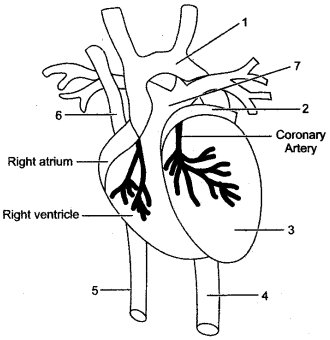
Answer: (i) 1. Aorta, 2. Left atrium, 3. Left ventricle, 4. Dorsal aorta, 5. Inferior vena cava, 6.Superior vena cava, 7. Pulmonary artery.
(ii) If the coronary artery gets an internal clot, the corresponding part of the heart does not get its blood supply. This will result in loss of contraction or even death of the cardiac cells resulting in a heart attack or coronary arrest which may prove to be fatal.
(iii) Part ‘5’ which is the inferior vena cava carries deoxygenated blood which is rich in CO2 and metabolic wastes.
(iv) Part ‘5’ is more muscular and lumen is narrow while part ‘4’ is less muscular and lumen is wider.
Question 2: Given below is the simplified pathway of the circulatory system :
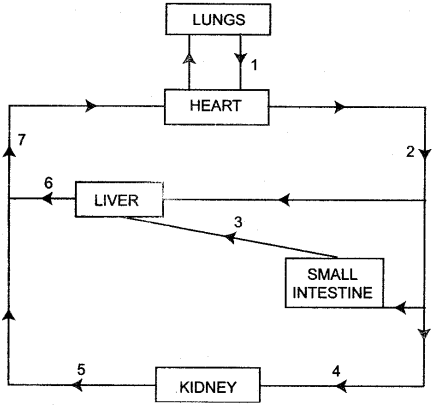
(i) Name the blood vessels marked 1 to 8.
(ii) Name the chamber of the heart which:
(a) Receives blood from ‘1’.
(b) Pumps blood into blood vessel ‘8’.
(iii) Mention two structural differences between blood vessels ‘7’ and ‘2’.
Answer: (i) 1. Pulmonary vein, 2. Dorsal aorta, 3. Hepatic portal vein, 4. Renal artery, 5. Iliac vein, 6. Hepatic vein, 7. Inferior vena-cava, 8. Pulmonary artery.
(ii) (a) Left auricle.
(b) Right ventricle.
(iii) (a) The inferior vena cava arises from iliac veins coming from the hind limbs, while the dorsal aorta arises from the left ventricle and continues behind as the abdominal aorta.
(b) The deoxygenated blood is collected by the inferior vena cava, while the branches of the dorsal aorta supplies oxygenated blood to the body parts.
Question 3: Given below is a schematic representation of the circulatory system in man. Study the same and answer the questions that follow:
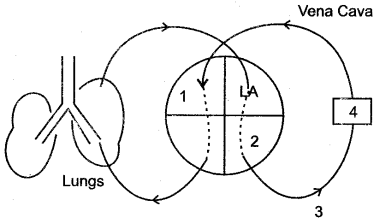
(i) Label the parts 1 to 4 indicated in the diagram.
(ii) Give one difference between the parts 1 and 2 based on:
(a) their structure
(b) the nature of blood flowing through them.
(iii) What is the specific name of the type of blood circulation that takes place between the heart and the lungs ?
(iv) Name the valve found at the beginning of the part labeled 3.
Answer: (i) 1. Right auricle
2. Left ventricle
3. Aorta
4. Body organs
(ii)
| Right Auricle | Left Ventricle |
| The wall of right auricle is thinner and smooth. | The wall of left ventricle is thicker and rough. |
| The deoxygenated blood flows. | The oxygenated blood flows. |
(iii) Pulmonary circulation.
(iv) Aortic semilunar valve.
Question 4: Given alongside is a highly diagrammatic sketch of the internal structure of the human heart: (i) Name the parts numbered 1-11. (ii) What is the main difference in the quality of blood contained in parts 6 and 7 ?
Answer: (i) 1. Anterior or superior vena cava
2. Pulmonary vein.
3. Mitral or bicuspid valve.
4. Dorsal aorta.
5. Semilurlar aortic valve.
6. Left ventricle.
7. Right ventricle
8. Pulmonary semilunar valve.
9. Pulmonary artery.
10. Tricuspid valve.
11. Right atrium.
(ii) Part 6 contains oxygenated blood whereas part 7 contains deoxygenated blood.
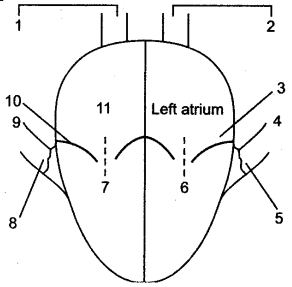
Question 5: The diagram below represents the simplified pathway of the circulation of blood. Study the same and answer the questions that follow:
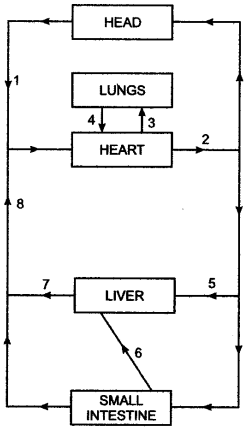
(i) Name the blood vessels labeled 1 and 2.
(ii) State the function of blood vessels labeled 5 and 8.
(iii) What is the importance of the blood vessel labeled 6 ?
(iv) Which blood vessel will contain a high amount of glucose and amino acids after a meal ?
(v) Draw a diagram of the different blood cells as seen in a smear of human blood.
Answer: (i) (1) Anterior vena cava.
(2) Aorta
(ii) (5) Carries oxygenated blood to the liver.
(8) Brings deoxygenated blood from lower parts of the body to heart.
(iii) It brings all the digested food and deoxygenated blood from parts of alimentary canal to liver.
(iv) Blood vessel number 6.
(v)

Question 6: The figures given below are cross-sections of blood vessels.

(i) Identify the blood vessels A, B and C.
(ii) Name the parts labeled 1-4.
(iii) Mention two structural differences between A and B.
(iv) Name the type of blood A that flows (a) through A, (b) through B.
(v) In which of the above vessels referred to in (iv) above does exchange of gases actually take place ?
Answer: (i) (A) Artery, (B) Vein, (C) Capillary.
(ii) 1. Connective tissue
2. Lumen.
3. Tunica media.
4. Tunica intima/Endothelium.
(iii) Two structural differences between arteries and veins are :
(a) Arteries are thick-walled and veins are thin walled.
(b) There are no valves in arteries while valves are present in veins.
(iv) (a) Oxygenated blood flows through A.
(b) Deoxygenated blood flows through B.
(v) The exchange of gases takes place in C capillaries.
Question 7: Given below is a simple diagram of the circulation of blood in a mammal showing the main blood vessels, the heart, lungs and body tissues. The blood vessel labeled 6 contains deoxygenated blood and 2 the valve leading to it has three semi-lunar pockets.
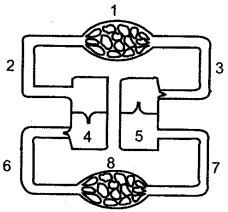
(i) Name the blood vessels of organs marked by number 1 to 8.
(ii) What do you mean by the term ‘double circulation’ of blood in mammals ?
(iii) What is diastole ?
Answer: (i) 1. Veins from tissues.
2. Superior vena cava
3. Aorta
4. Right ventricle
5. Left ventricle
6. Pulmonary Artery
7. Pulmonary vein
8. Lungs.
(ii) The heart is said to have double circulation because the blood passes through the heart twice.
(a) It first leaves t.rough the right ventricle, goes to the lungs and then returns to the left auricle of heart (pulmonary circulation).
(b) It leaves through the leftyentricle, circulates through the body, and again returns to the right auricle of heart (systemic circulation).
(iii) Diastole is the phase of relaxation of the heart muscles during which the heart chambers fill with blood and the supply of blood to the cardiac muscle is improved.
Question 8: The diagram given below represents the human heart in one phase of its activity. Study the same and then answer the questions that follow:
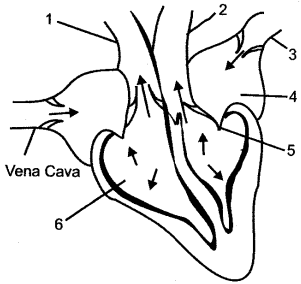
(i) Name the phase.
(ii) Which parts of the heart are contracting in this phase ? Give a reason to support your answer.
(iii) Name the part numbered 1 to 6.
(iv) What type of blood flows through the parts marked ‘1’ and ‘2’?
(v) How many valves are closed in this phase?
Answer: (i) Ventricular systole.
(ii) Both ventricles are contracting in this phase, because both bicuspid and tricuspid valves are closed in order to prevent the back flow of blood into auricles and the semilunar valves are open.
(iii) 1. Pulmonary artery,
2. Aorta,
3. Pulmonary vein,
4. Left auricle,
5. Bicuspid valve (mitral valve),
6. Right ventricle.
(iv) ‘1’—carnes deoxygenated blood. ‘2’—carries oxygenated blood.
(v) Two (Bicuspid and Tricuspid) valves.
Question 9: The figure below represents die internal structure of a mammalian heart and the associated blood vessels.
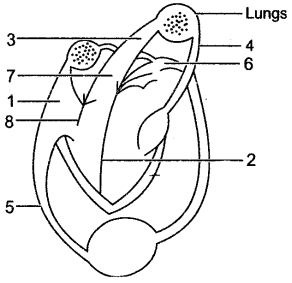
(i) (a) Name each of the structures labeled 1, 2, 3, 4, 5, 6, 7 and 8.
(b) State the function of each of the structures 5, 6, 7 and 8.
(ii) (a) State the function of heart as an entire organ.
(b) Why are the walls of the left ventricle more muscular than the right ?
Answer: (i) (a) 1. Right auricle,
2. Left ventricle,
3. Pulmonary artery,
4. Pulmonary vein,
5. Inferior vena cava,
6. Aorta,
7. Pulmonary semilunar valve,
8. Tricuspid valve.
(b) 5 — carry deoxygenated blood from the body parts to the right auricle of the heart.
6 — distributes blood all over the body.
7 — prevents the back flow of the blood into the ventricles.
8 — prevents the reverse flow of the blood from right ventricle into the right auricle,
(ii) (a) The heart makes the blood to circulate all over the body.
(b) The walls of left ventricle are more muscular because they have to pump blood to a larger distance than the right so that walls have to withstand a high pressure.
Question 10: The diagrams given below show the cross section of two kinds of blood vessels:
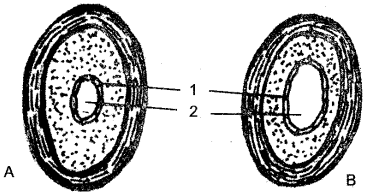
(i) Identify the blood vessels A and B. In each case give a reason to support your answer.
(ii) Name the parts numbered 1 and 2.
(iii) When are the sounds “LUBB” and “DUB” produced during a heartbeat ?
(iv) Name the blood vessel that
(a) begins and ends in capillaries.
(b) supplies blood to the walls of the heart.
Answer: (i) A—Artery, B—Vein, because in A lumen is narrow, in B lumen is wide.
(ii) 1 —> Endothelium, 2 —> Lumen.
(iii) Lubb is produced when ventricles contract and atrio-ventricular valves get closed at the beginning of ventricular systole.
Dub is produced by the closure of semilunar valves at the beginning of ventricular diastole.
(iv) (a) Portal system
(b) Coronary arteries
Question 11: The diagram given below represents the human heart in one phase of its functional activities. Study the same and answer the questions that follow:

(ii) Label the parts 1, 2 and 3
(iii) Which part of the heart is contracting in this phase ? Give a reason to support your answer.
Answer: (i) Atrial systole.
(ii) (1) Left pulmonary artery
(2) Superior vena cava
(3) Aorta.
(iii) Simultaneous contraction of both the auricles. Because the cuspid valves are open, allowing blood to flow into ventricles.
Question 12: The diagram shows different types of blood cells, Name them.
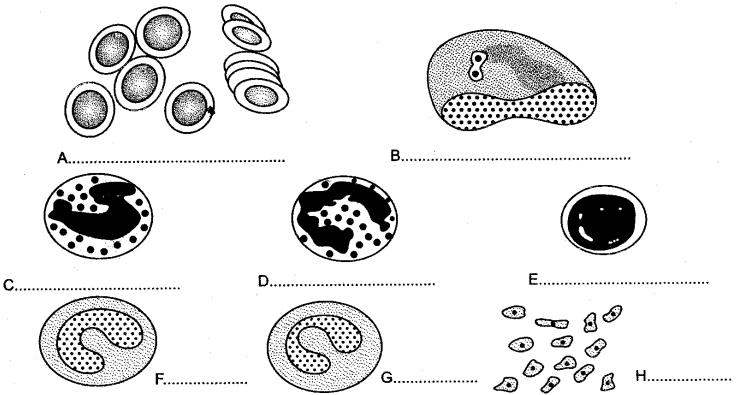
Answer: (A) Red blood cells (B) RBC in section (C) Basophil (D) Neutrophil (E) Lymphocyte (F) Monocyte (G) Eosinophil (H) Platelets.
Question 13: The diagram below represents a certain category of blood vessels showing the role of a special structure in their walls :
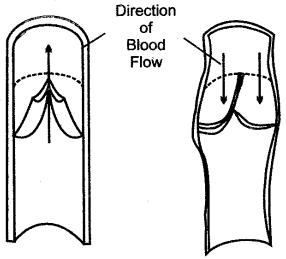
(i) Name the kind of blood vessels shown.
(ii) What is the structure shown inside the blood vessels ?
(iii) What is the role of these structures ?
(iv) Are these structures present in any other kind of blood vessel ? If so, name it.
(v) Towards which side of the figure (Top or Bottom) is the heart located ?
Answer: (i) Veins.
(ii) Pocket valves.
(iii) These structures maintain the flow of blood in one direction only by preventing its back¬flow.
(iv) Yes. These are present in lymph vessels.
(v) The heart is located towards the top side of the figure.
Question 14: The diagram represents the ‘closed system’ or ‘double circulation’ of blood in mammals.

Justify the above statement.
State two structural and two functional differences between the arteries and veins.
State the changes in the composition of blood as it passes through the following organs :
(a) Lungs (b) Gut (c) Liver (d) Kidneys.
Answer: Double circulation or closed system : In human beings, the heart has double circulation as the blood passes through the heart twice.
(1) It first leaves the heart (right ventricle) and goes to lungs and then returns to the heart (left auricle).
(2) From the left auricle it circulates through the entire body and again returns to the heart (right auricle).
See Answer to Question 11, differentiate between.
(a) In lungs, the blood releases carbon dioxide and picks up oxygen.
Hence before passing through the lungs it contains more CO2 while it contains more oxygen after it has passed through the lungs.
(b) When blood passes through the gut, it absorbs digested food materials i.e., it contain more carbohydrates, proteins, fats, water, ions and vitamins.
(c) As the blood passes through liver, it contains more urea another waste materials.
(d) As the blood passes through kidneys, it contains less urea and other waste materials.
Sketch and Label the Diagram
Question 1: Draw the diagrams external features of heart.
Answer:
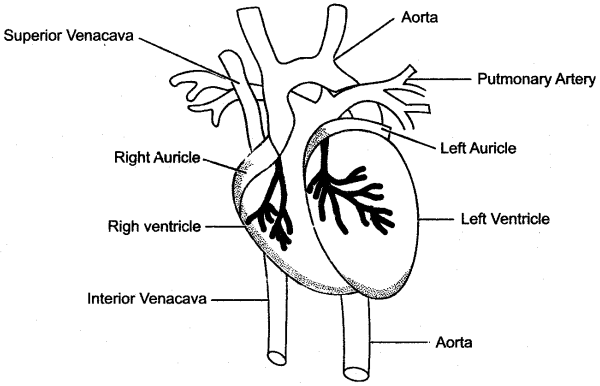
Question 2: Position of valves in human heart.
Answer:
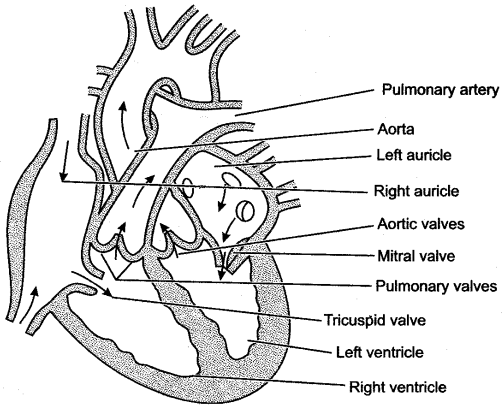
Question 3: Draw well labeled diagrams of part Artery and Superior vena cava to show the structural.
Answer: (i) Artery
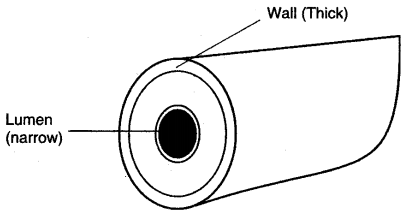
(ii) Superior vena cava
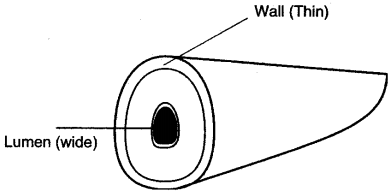
Explain the Terms
Question:
1. Blood Pressure
2. Pulse rate
3. Double Circulation
4. Hepatic Portal System
5. Diapedesis
6. Haemopoiesis
7. Phagocytosis
8. Electrocardiogram (ECG)
9. Pace maker
Answer: 1. When the blood flows in the artery it exerts a pressure on the elastic wall of the artery which is called blood pressure. It is greater during systole (contraction) than during diastole (relaxation) of the heart. In a normal adult the blood pressure is 120/80 where systolic is 120 and diastolic pressure is 80 mm of Hg (mercury).
2. Pulse rate indicates the rate at which the heart beats. Each heartbeat results from the contraction (systole) and relaxation (diastole) of the heart. Both the auricles contract at a time and pour the blood into the main artery (dorsal aorta). The systole and diastole take 0.8 secs., which is 75 beats per minute.
3. In mammals the heart produces two separate circulations, the pulmonary to the lungs and systemic to the rest of the body. These two separate circulations are jointly called double circulation. From the right ventricle deoxygenated blood goes to lung for purification and
comes back to left auricle through pulmonary vein after purification which is known as pulmonary circulation,. Distribution of blood from left ventricle to different parts of the body and back to hearts as deoxygenated blood is known as systemic circulation.
4. Systems of veins carrying blood capillaries of intestine to liver in mammals is called hepatic portal system. The blood from the intestine carries digested carbohydrates and proteins, i.e., glucose and amino acids to the liver which converts them into glycogen and urea respectively.
5. The passage of White Blood Corpuscles through unruptured wall of blood vessels is known as diapedesis. It also helps in engulfing the germs and also protects the body from getting infected.
6. Formation of blood corpuscles like WBC and RBC by the bone marrow and lymph nodes is called haemopoiesis. Bone marrow and lymph nodes are called haemopoietic tissues.
7. When WBC engulfs the damaged tissues bacteria and germs, the phenomenon is called phagocytosis.
8. Electrocardiogram is the recorded report of an electrocardiograph which is produced by the heart muscle during the cardiac cycle of contraction and relaxation.
9. The tissue present on the wall of the right auricle where initiation of heart beat starts is known as a pace maker.
Name the Following
Question:
1. The study of blood vascular system including arteries, veins and heart.
2. Number of chambers present in the human heart.
3. Name the muscles which made up the wall of the heart.
4. Layer, which surrounds the heart.
5. The blood vessel leaving the left ventricle of the mammalian heart.
6. The valve present between the left atrium and the left ventricle.
7. The blood vessel supplying blood to the kidney.
8. The blood vessel that begins and ends in capillaries.
9. The blood vessels which have valves in them.
10. The fine blood vessels in the tissues through which exchange of materials occurs
11. The number of RBCs in men.
12. The instrument by which RBC are counted is called.
13. Oxygen is transported by the blood in the form of
14. The enzyme which converts fibrinogen to fibrin.
15. The blood plasma from which fibrinogen has been removed.
16. By which the human body is protected from invading bacteria.
Answer:
1. Angiology
2. Four
3. Cardiac muscles
4. Pericardium
5. Dorsal aorta
6. Bicuspid valve
7. Renal artery
8. Hepatic portal vein
9. Veins
10. Capillaries
11. 5,000,000/mm3
12. Haemocytometer
13. Oxyhaemoglobin
14. Thrombokinase
15. Serum
16. W.B.C
Give Technical Terms
Question:
1. What is the approximate weight of heart of a man ?
2. An unstable bright red compound formed between haemoglobin and oxygen to carry the oxygen to the body cells.
3. An artery which carries de-oxygenated blood.
4. Name the vein in the human body which carries oxygenated blood.
5. Name the metallic element present in red blood cells.
6. A fluid that transports fatty acids and glycerols.
7. The phase of cardiac cycle in which the auricles contract.
8. The respiratory pigment contained in human blood.
9. The blood vessel that supplies oxygenated blood to the liver.
10. Name an instrument which is used to hear heart sounds.
11. The mineral element essential for the clotting of blood.
12. The soluble protein present in blood plasma responsible for blood clotting.
13. The process by which leucocytes engulf and destroy bacteria.
14. WBCs squeeze through the walls of the capillaries into the tissue.
15. The artificial method of filtering the blood or removing the wastes from the blood.
Answer:
1. 300 gm (approx.)
2. Oxyhaemoglobin
3. Pulmonary artery
4. Pulmonary vein
5. Iron 6. Lymph
7. Atrial systole
8. Haemoglobin
9. Hepatic artery
10. Stethoscope
11. Calcium
12. Prothrombin
13. Phagocytosis
14. Diapedesis
15. Dialysis
Fill in the Blanks
Complete the following sentences with appropriate words :
1. The iron pigment Haemoglobin gives red colour to the blood.
2. The Heart is the most powerful organ in the circulatory system.
3. The average heartbeat rate is 72 beats per minute in human being.
4. In man (human), heart has Four chambers.
5. The erythrocytes contain an iron-rich pigment called Haemoglobin.
6. Non-coagulation of blood is called Haemophilia.
7. When oxygen is in fairly high concentration, the haemoglobin quickly combines with it and forms an unstable compound known as Oxyhaemoglobin.
8. The element required for blood clotting is Calcium.
9. Thrombocyte helps in blood clotting.
10. The three distinct types of blood vessels are Arteries, veins and the capillaries.
11. The site of production of W.B.Cs in the embryo is Red bone marrow.
12. The Spleen is referred to as the graveyard of red blood corpuscles and the bone marrow referred to as the cradle of red blood corpuscles.
13. The red blood corpuscles are Biconcave and disc shaped cells without nucleus.
14. The fluid in the space between the tissue cell is called Tissue fluid/interstitial fluid.
15. The foundations of physiology were laid by the physician William Harvey.
16. Beside food, oxygen and waste materials, circulatory system transports Hormones to various parts of the body.
17. Arteries are the blood vessels which usually carry oxygenated blood.
18. The chamber of heart which pumps blood into aorta is Left ventricle.
19. Arteries are Thick walled and the veins are thin walled vessels.
20. The blood vessel which transports blood from heart to an organ is called Artery.
21. The sequence of one systole followed by one diastole is termed as the Cardiac cycle.
22. The membranous covering of the heart is Pericardium.
23. The heart is made up of special muscles, the Cardiac muscles.
24. The blood vessel that begins and ends in capillaries is the Portal vein.
25. The blood vessel leaving the left ventricle of the mammalian heart is the Left aorta.
True & False
Mention, if the following statements are True or False. If false rewrite the wrong statement in its correct form:
1. The heart of a normal human adult beats more than one lakh times per day. (True)
2. W.B.C. contains haemoglobin. (False, RBC contains haemoglobin.)
3. R.B.Cs are of several kinds whereas WBCs are of one kind. (False, RBCs are of one kind whereas WBCs are of several kinds.)
4. Leucocytes show amoeboid movement. (True)
5. The average life of red blood cells in our body is about 120 hours. (False, The average life of a red blood cell in our body is about 120 days.)
6. Serum is an immunological preparation of blood (without cells and fibrinogen) containing antibodies and antitoxins against specific diseases. (True)
7. Blood group AB is universal donor. (False, Blood group O is a universal donor.)
8. The walls of auricles are thicker than those of ventricles. (False, The walls of auricles are thinner than those of ventricles.)
State the Location
| Name | Location |
| Hepatic portal vein | It is located between alimentary canal and liver. |
| Tonsils | They are located in the posterior wall of nasopharynx. |
| Spleen | It is located just beneath the stomach. |
| Sino-auricular node | It is a special kind of muscle located in the heart. |
| Bicuspid value | It is located in between the left auricle (atrium) and left ventricle left auricle. |
| Pulmonary vein | Arises from lungs and pours blood into the left auricle. |
| Semilunar valves of the heart | Located in the arteries leaving the heart. |
| Bundle of His | Arises from atrio ventricular node, moves along inter-ventricular septum to the apex of ventricle and then radiates upwards. |
State the Function
Write the functional activity of the following structures:
| Name | Function |
| Pulmonary vein | Brings oxygenated blood from lungs to the heart for circulation throughout the body. |
| Thrombocytes | Helps in clotting of blood. |
| Semilunar valves of the heart. | They preyent the back flow of blood from the pulmonary artery and aorta into the heart. |
| Bundle of His | They carry the wave of excitation from atrio ventricular node to the.ventricles. |
| Coronary artery | It carries blood to the muscles of heart.. |
| Bicuspid valve | It prevents the reverse flow of blood from the left ventricle into the left auricle. |
| Haemoglobin | It is the respiratory pigment, helps to carry O2 to the body parts. |
| Vitamin K | Helps in clotting of blood. |
| Pericardium | It protects the heart. |
| Pulmonary artery | To Transports deoxygenated blood to the lungs. |
| Lymph | It transports fatty acids and glycerol, it also protects the body against microorganisms. |
| W.B.C. | To fight against micro organism by producing antibodies. |
| R.B.C. | To transports oxygen to the body parts. |
| Platelets | Helps in bloods clotting. |
| Tricuspid valve | It prevents the reverse flow of blood from the right ventricle into the left auricle. |
| Chordae tendinae | To keep the cuspid valves in position. |
| Vena cava | To carry deoxygenated blood from the body parts to the right auricle of the heart. |
Choose the Odd One Out
1. Human heart, Fish heart, Reptile heart, Toad heart. (Heart Fish)
2. Artery, Vein, Portal vein, Lacteal. (Lacteal)
3. RBC, ATP, WBC, Platelets. (ATP)
4. Purkinje fibres, A. V. node, A. V. valve, S. A. node. (A.V. Values)
5. Mitral valve, Tricuspid valve, Semilunar valve, Venous valve. (Venous Value)
6. Systolic pressure, Diastolic pressure, Stethoscope, Sphygmomanometer. (Stethescope)
Multiple Choice Questions
1. The function of WBC is:
(a) To distribute heat (b) To protect enzymes
(c) To cause blood clotting (d) To destroy bacteria
3. The chief function of lymph nodes in mammaJs is to:
(a) Produce WBC’s (b) Produce hormones
(c) Destroy old RBC’s (d) Destroy pathogens
2. Agranulocytes are:
(a) Lymphocytes, monocytes (b) Lymphocytes, basophils
(c) Eosinophils, basophils (d) Eosinophils, monocytes
4 What will happen if the spleen of a man is removed?
(a) W.B.C. production will be lowered
(b) Removal of dead RBC will not take place
(c) Antibody production will be decreased
(d) R.B.C. production will be stopped
5. Which protein is used in preventing dotting of blood?
(a) Albumin (b) Heparin
(c) Fibrinogeri (d) Globulin
6. The beating of the heart of man is hearl on the left side, because:
(a) The left ventride is towards the left side
(b) Both the ventricles are towards the left side
(c) Contraction of heart is powerful on left side.
(d) The dorsal aorta is on the left side
7. Arteries are:
(a) Thin walled and blood flows under diminished pressure
(b) Thick walled and blood flows under high pressure
(c) Thin walled and blood flows under low pressure
(d) Thick walled and blood flows under diminished pressure
8. What is blood pressure?
(a) The pressure of blood on the heart muscles
(b) The pressure of blood exerted on the walls of arteries and veins
(c) The pressure of blood on the walls of veins only
(d) The pressure of blood on the walls of arteries only
9. Erythroblastosis foetalis can occur when:
(a) Man Rh+ve and woman Rh+ve (b) Man Rh+ve and woman Rh+ve
(c) Man Rh+ve and woman Rh+ve (d) Man Rh+ve and woman Rh+ve
10. Blood pressure is measured by:
(a) Electrocardiogram (ECG) (b) Stethoscope
(c) Sphygmomanometer (d) Pulse rate
Match the Column
Column ‘II’ is a list of items related to ideas in Column ‘I’. Match the term in Column ‘II’ with the suitable idea given in Column ‘I’.
| Column I | Column II |
| (i) Superior vena cava | (a) Collect deoxygenated blood from the wall of the heart. |
| (ii) Inferior vena cava | (b) Carry oxygenated blood to heart muscle. |
| (iii) Pulmonary vein | (c) Collects deoxygenated blood from upper part. |
| (iv) Coronary veins | (d) Collects deoxygenated blood from lower parts. |
| (v) Coronary artery | (e) Brings oxygenated blood from lungs. |
| (vi) Aorta | (f) Large artery |
| (vii) Heart attack | (g) Large vein |
| (viii) Blood Pressure | (h) Oxygenated blood |
| (ix) Tricuspid valve | (i) Sphygmomanometer |
| (x) Bicuspid valve | (j) Allows blood flow from right auricle to right ventricle. |
| (xi) Contraction and relaxation of heart | (k) Blocking of coronary arteries. |
| (l) Cardiac muscle. | |
| (m) Allows blood flow from left auricle to left ventricle. | |
| (n) Allows blood flow from right ventricle of pulmonary aorta. |
Answer: (i) (c) (ii) (d) (iii) (e) (iv) (a) (v) (b) (vi) (c) (vii) (c) (viii) (a) (ix) (b) (x) (e) (xi) (d)
ICSE Solutions for Class 10 Biology
- Cell Division Class 10 ICSE Questions and Answers
- Fundamentals of Genetics Class 10 ICSE Questions and Answers
- Absorption by Roots Class 10 ICSE Questions and Answers
- Transpiration Class 10 ICSE Questions and Answers
- Photosynthesis Class 10 ICSE Questions and Answers
- The Circulatory System Class 10 ICSE Questions and Answers
- The Excretory System Class 10 ICSE Questions and Answers
- The Nervous System and Sense Organs Class 10 ICSE Questions and Answers
- The Endocrine System Class 10 ICSE Questions and Answers
- The Reproductive System Class 10 ICSE Questions and Answers
- Human Population Class 10 ICSE Questions and Answers
- Physical Health and Hygiene Class 10 ICSE Questions and Answers
- Pollution Class 10 ICSE Questions and Answers
